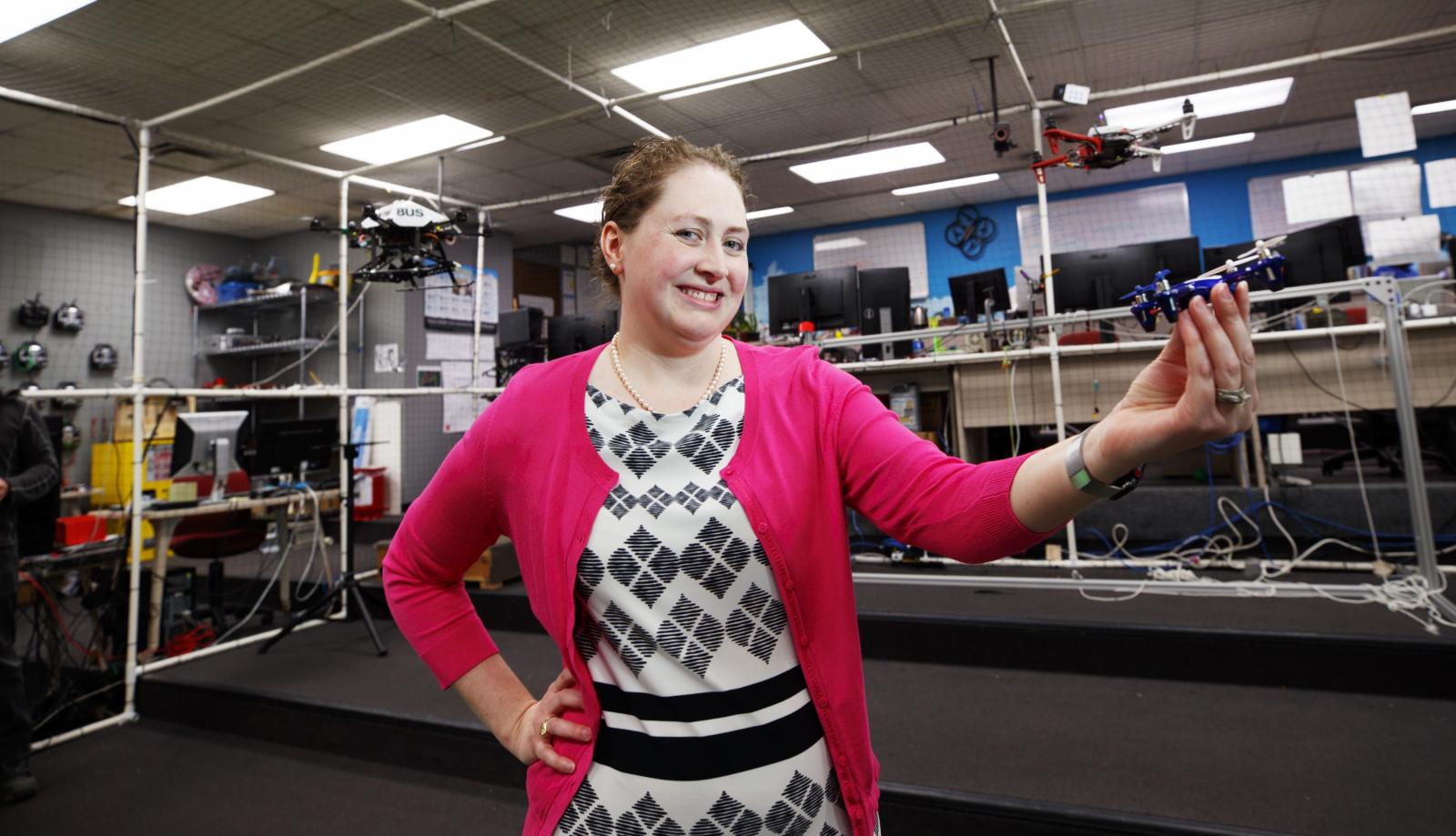This project is funded in part by the National Science Foundation through grant #NSF-CAREER: 170750.
Project Description:
Drones, or small Unmanned Aerial Vehicles (sUAVs), are one of the most well adopted types of robot and have become ubiquitous in public spaces since the introduction of the AR.Drone in 2010. While these platforms have become common in outdoor spaces for applications in agriculture and public safety, design limitations and lack of interaction principles have limited their adoption for indoor uses, such as for safety or security applications. The overall goal of this CAREER proposal is to address the intertwined challenge of creating broad interaction principles for distancing and communicative flight paths from sUAVs in various spaces with diverse users so that when design limitations, such as indoor navigation and battery life, are solved they will be capable of safe, efficient, and informative interactions.
The long-term research goal of this work is to identify key communication failures or barriers between humans and robots, which can create unsafe and inefficient interactions, and develop strategies to avoid these problems. The research goal of this project, which is the next step toward the long-term research goal, is to develop guidelines for gestural communication from the vehicle to the user in order to generate safer and more natural interactions, while respecting personal space requirements. This work contains three parallel research objectives related to gestural communications by sUAVs and comfortable distancing:
- Objective 1 will focus on the use of communicative motions of state information from the vehicle. Gestures will be generated through methods for participatory design and tested using social sciences methods.
- Objective 2 will focus on distancing with sUAVs, informed by methods from the social sciences, and will use an existing room in the PI’s laboratory with movable walls, video cameras, and a motion capture system.
- Finally, Objective 3 will be a combined investigation, focusing on efficient signaling, incorporating the distancing work into the flight paths, and reception with users performing tasks.
Participants:
- PI: Brittany Duncan
- GRA: Justin Firestone
- GRA: Siya Kunde
- GRA: Alisha Bevins
- GRA: Paul Fletcher
- GRA: Mike Turner
- GRA: Karissa Jelonek
- GRA: Taylor Brandl
- UGRAD: Mo Sbai
- UGRAD: Hadley Susie
- UGRAD: Malka Lazerson
- UGRAD: Jemin Oh
- UGRAD: Kristen Hallas
- UGRAD: Grace Venator
- UGRAD: Jayden Carlon
- UGRAD: Clara Perez
- UGRAD: Maliik Jones
- UGRAD: Elizabeth Weber
- UGRAD: Angeline Luther
- UGRAD: Riley Goodling
- UGRAD: Nathan Simms
- UGRAD: Evan Palmer
- UGRAD: Abigail Seibel
- UGRAD: Gerson Uriarte
- UGRAD: Nina McPhaul
- UGRAD: Geoffrey Chanenson
- UGRAD: Midia Yousif
- UGRAD: Clara Perez
- UGRAD: Joann Jones
Publications:
- S Kunde, N Simms, G Uriarte, B Duncan, (2022) "Let’s Run an Online Proxemics Study! But, How Do Results Compare to In-Person?" In Proceedings of Social Robotics: 14th International Conference, ICSR 2022, Florence, Italy
- K Jelonek, P Fletcher, B Duncan, C Detweiler, (2022) "Examining Distance in UAV Gesture Perception" In Proceedings of 2022 IEEE/RSJ International Conference on Intelligent Robots and Systems
- P Fletcher, A Luther, C Detweiler, B Duncan, (2022) "Predicting Visual Differentiability for Unmanned Aerial Vehicle Gestures" IEEE Robotics and Automation Letters 7 (4), 11799-11806.
- S Kunde, E Palmer, B Duncan, (2022) "Recognizing User Proficiency in Piloting Small Unmanned Aerial Vehicles (sUAV)" IEEE Robotics and Automation Letters 7 (2), 2345-2352.
- A Bevins, BA Duncan"Aerial Flight Paths for Communication" Frontiers in Robotics and AI 8, 719154.
- Bevins, Alisha, and Brittany A. Duncan. (2021). "Aerial Flight Paths for Communication: How Participants Perceive and Intend to Respond to Drone Movements." In Proceedings of the 2021 ACM/IEEE International Conference on Human-Robot Interaction, pp. 16-23.
- Bevins, Alisha, Nina McPhaul, and Brittany A. Duncan. (2020). "Content Is King: Impact of Task Design for Eliciting Participant Agreement in Crowdsourcing for HRI." In International Conference on Social Robotics, pp. 640-651. Springer, Cham.
- Kunde, Siya, Sebastian Elbaum, and Brittany A. Duncan. (2020). "Characterizing User Responses to Failures in Aerial Autonomous Systems." IEEE Robotics and Automation Letters 5, no. 2: 1587-1594.
- Firestone, Justin W., Quinones, Rubi, and Duncan, Brittany A. (2019). Learning from Users: an Elicitation Study and Taxonomy for Communicating Small Unmanned Aerial System States Through Gestures, 14th ACM/IEEE International Conference on Human-Robot Interaction (HRI), pgs 163 to 171, DOI: 10.1109/hri.2019.8673010. Best Paper Nominee
